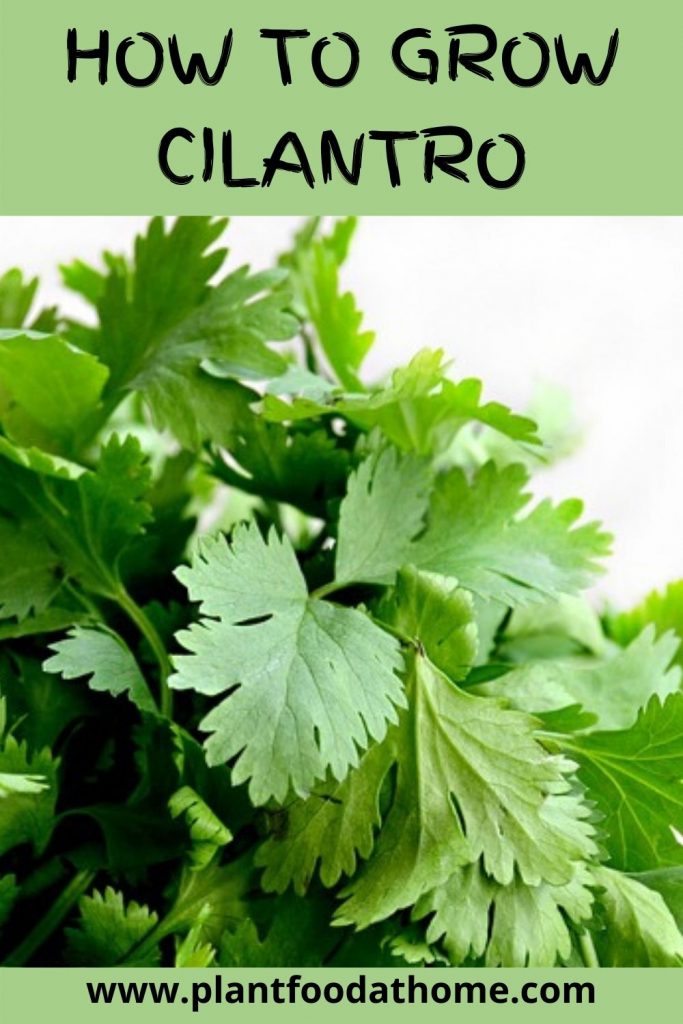Growing cilantro means you will have the fresh leafy herb on hand, in the garden, for when you need it. Garnishing curries and topping tacos with cilantro is super easy when you can simply harvest the quantity you need, leaving the rest to grow for another day and another meal. So let’s dig in and find out exactly how to grow cilantro.
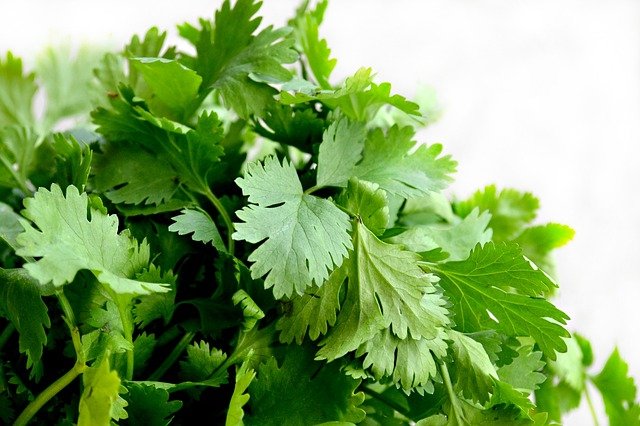
Table of Contents
- What Is Cilantro?
- How To Grow Cilantro
- Cilantro Varieties
- Growing Cilantro From Seed
- Reduce Transplant Shock By Hardening Off Seedlings
- Plant Cilantro In The Garden
- Growing Cilantro In Pots
- How Long Does It Take For Cilantro To Grow
- How To Harvest Cilantro
- How To Store Cilantro
- How to Collect and Harvest Coriander Seeds
- Cilantro Pests and Diseases
- Conclusion
- Recommended Products
What Is Cilantro?
Firstly, what is cilantro, and is coriander also cilantro? Well, they are both parts of the same plant.
Cilantro
Cilantro (botanical name Coriandrum sativum), refers to the feathery leaves of the plant. In other parts of the world, it is also called coriander leaf, fresh coriander, Chinese parsley, and Mexican parsley.
Cilantro is a short-lived annual herb and part of the Apiaceae family which includes carrot, dill, and parsley among others.
Coriander
Coriander refers to the seeds of the plant which are small and ridged, mostly yellowish-brown in color. Coriander seeds are used whole or ground up and used as a spice. The coriander seeds develop after the plant flowers.
The roots of the plant are also edible and used in dishes.
Cilantro can grow 20 inches (50cm) tall and are native to the regions of Southern Europe, Northern Africa, and Southwestern Asia. With its unique and distinct flavor, it is an essential herb in many Mexican, Middle Eastern, Indian, and Asian cuisines.
How To Grow Cilantro
Climate
As a cool-weather herb, cilantro grows best in cooler temperatures between 50°F (10°C) and 85°F (29°C). For this reason, cilantro is usually grown in spring and fall
Cilantro can withstand some frost but not if the ground freezes. And if temperatures pass 85°F (29°C), cilantro will become heat stressed and bolt. This means it will flower and then set seed. The plant will stop producing leaves and the leaves that do remain on the bolted cilantro plant will be unpleasant to eat.
Soil
Cilantro prefers moist, well-drained soil, with a pH level of 6.2 to 6.8
Add compost and well-rotted manure prior to planting to provide the herb with essential soil nutrients and ideal growing conditions.
You can monitor the soil pH with a soil gauge.
Sun
Cilantro grows best in full and partial sun. Avoid positioning cilantro where it will receive midday sun in warm climates.
When the weather heats up, cilantro can become too hot and if stressed by heat, cilantro will bolt by finishing its life cycle by first producing flowers and then seeds.
During spring and fall, cilantro can tolerate more sun, depending on the climate.
Water
As an established soft-leafed herb, cilantro thrives with consistent and regular watering in soil that drains freely.
Soil should not be soggy, so during times of rain, hold off the watering and during times of warmer weather, cilantro may need daily watering.
Watering at the base of the plant is preferable to minimize potential diseases caused by overhead watering and soggy soil.
You can monitor the soil moisture with a water gauge.
Fertilizer
Fertilizer can be applied a few times during the plant’s growing season. The addition of an organic herb fertilizer such as this one will provide beneficial nutrients for a healthy cilantro plant.
However, cilantro should not be over-fertilized – too much nitrogen can adversely affect the flavor of the leaves.
Starting with healthy soil topped with well-composted organic matter will greatly improve the plant’s vigor.
Cilantro Varieties
There are a lot of varieties of cilantro including Coriandrum sativum (a popular heirloom variety), Leisure, Slow Bolt, Long Standing, Calypso, Cruiser, Jantar, Santo, Costa Rica, Delfino, and Moroccan.
Slow Bolt, Long Standing, and Leisure are very flavorful and slow to bolt.
Growing Cilantro From Seed
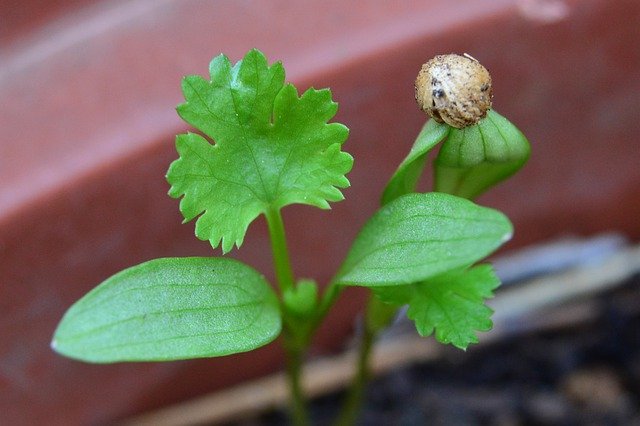
Because cilantro grows a big tap root, it makes them fragile to transplant. Therefore it’s preferable to grow cilantro from seed.
Seeds can be started directly in the garden or pot where they will grow or in seed-raising pots to transplant later. For successful transplanting, seed-raising peat pots are a good option as they will minimize root disturbance.
Start with quality soil, either enriched with organic matter or a quality seed-raising soil mix.
Sow seed 1/4 inch (.5cm) deep in soil and water well. Watering at this point will help start the germination process. Keep the soil moist during this time, but not soggy. It’s well worth using a misting water bottle during seed germination so as not to disturb the soil and later the fragile seedlings.
In seed-raising pots, coriander seeds can be planted close together and later thinned out. I prefer to generously sprinkle the pot with seeds and then cover them lightly with soil.
Sowing directly in the garden can be done 2 inches (5 cm) apart in rows 12-15 inches (30-38 cm) apart. It’s worth planting 2-3 seeds in each hole and thinning them out later.
Keep the soil moist during germination, but not soggy.
Cilantro germination can take 3-4 weeks.
Frugal Gardening Tip: you can plant coriander seed sold in grocery stores, packaged as a spice. These seeds will produce cilantro plants. Make sure you choose the whole seed, not the ground coriander seed! This is a money-saving tip and germination may not be as high as those purchased from seed companies but you will get many more seeds in the packet which more than makes up for it. And by sowing more seed than you need, you can thin out the seedlings later if you achieve a high germination rate.

Reduce Transplant Shock By Hardening Off Seedlings
To reduce possible transplant shock, cilantro seedlings should be ‘hardened off’ before planting in their final position. If seedlings have been grown indoors, under shelter, or are purchased seedlings, then they will need to be gradually exposed to the outside elements and their final growing position prior to planting.
To harden off cilantro seedlings, on day one, place the seedlings outside in morning sun for 2 hours. Morning sun is ideal as it won’t be as strong as midday or afternoon sunlight.
Move the seedlings back into indirect light for the remainder of the day and return them to their previous growing environment for the night.
The following day, increase the direct sunlight hours by 1-2 hours and continue to do so over the next few days.
This process should take 7-10 days.
- Related Reading: Hardening Off Seedlings (& Avoiding Transplant Shock)
Plant Cilantro In The Garden
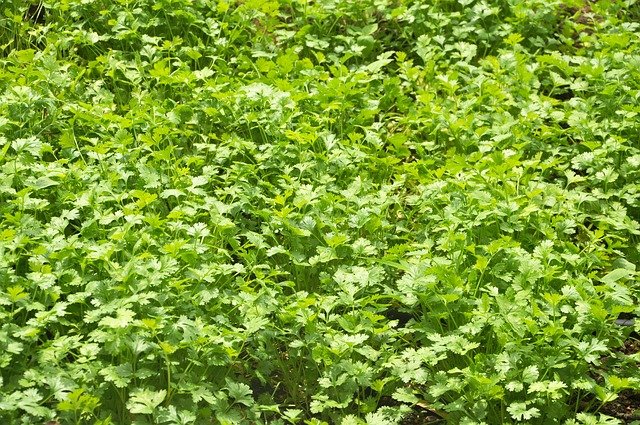
If planting out cilantro seedlings then the sooner seedlings can be transplanted to their final growing position the better. Remember cilantro really dislikes being transplanted due to its tap root. Any disturbance can be fatal to the plant or could cause the plant to flower prematurely. In saying that, I have successfully transplanted cilantro many times, so if you can’t raise your seed directly in the ground or in a permanent container, it is still well worth transplanting them.
Transplanting can begin when any chance of expected frost has passed and up to 6-8 weeks before frost.
When seedlings are 2-3 inches (5-7.5cm) high with a few true leaves (as opposed to the two seed leaves), they can be planted out in the garden 2 inches (5cm) apart in rows 12-15 inches (30-38cm) apart.
For seed production (growing coriander seed), plants will require a little more room at around 6-8 inches (15-20cm) apart.
Plant to the depth of the original soil level of the cilantro seedling.
Water newly planted seedlings well and keep up the watering while they establish.
Cilantro may wilt for a day or so after transplanting, which is known as transplant shock but will usually revive after a couple of days. Minimize the chance of transplant shock and wilting by:
- Avoid transplanting in the midday sun,
- Choose a cool day to transplant, or
- Transplant on an overcast day.
Mulch with an organic mulch to help conserve water and protect the soil.
Growing Cilantro In Pots
While cilantro can be grown directly in the garden, it also grows very well in pots and containers. And growing cilantro in pots makes it easy to move the plant.
If the weather gets too warm or too cold, you can move the entire pot to a place more conducive to the plant’s preferred growing conditions. This will help prolong the lifespan and productivity of the plant.
For growing cilantro in pots, choose a quality potting mix, plant seeds directly in the pot or plant seedlings around 3-4 inches (8-10cm) apart.
Water regularly to keep the soil moist. Pot and container-grown herbs require more water than ground-grown herbs as they dry out more quickly.
Adding organic mulch around the cilantro plant will help conserve moisture and protect the soil.
How Long Does It Take For Cilantro To Grow
It takes cilantro around 30-45 days from seed germination to be mature enough for harvesting to begin. Wait for the plant to grow at least 3-4 inches (8-10cm) high.
Depending on the variety, coriander seeds can start to set around 70 days. Before that the delicate white flowers attract beneficial insects, including pollinating bees, into the garden.
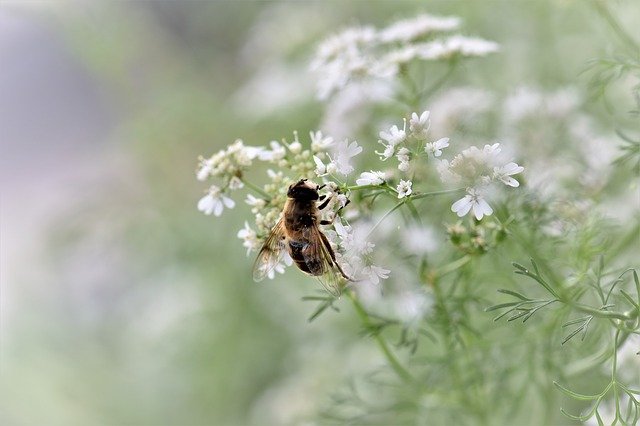
This makes cilantro a short-lived herb, so for a prolonged harvest season, succession plant new seeds every 3 weeks or so during the growing season.
How To Harvest Cilantro
Using garden clippers or scissors, choose the outside stems and cut the cilantro stems close to the base of the plant. The stem will then continue to grow.
You can harvest cilantro weekly or more if the plant is healthy and growing plenty of leaves. Regular harvesting will help keep cilantro from bolting to seed.
Cilantro plants have a short life cycle and harvesting the leaves regularly will increase the life span by encouraging further growth. Eventually, cilantro will flower and set seed, so succession sow new seeds for a longer harvest.
And if you’re looking for ways to use cilantro, check out this delicious our Vegan Tacos and this Vegan Cilantro Pesto recipe.
How To Store Cilantro
There are different ways to store cilantro. Here are some ideas:
- Place freshly harvested cilantro stems in a glass jar with 1 inch of water. Left on the kitchen counter, cilantro will keep fresh for 5-7 days. Change the water if it starts to discolor.
- Again, put freshly harvested cilantro stems in a glass jar with 1 inch of water. Then place a plastic bag over the glass jar, secure it with an elastic band, and place it in the refrigerator. Change the water when it starts to discolor, normally every couple of days. Cilantro can remain fresh for 1-2 weeks.
- Chop the leaves and fill ice cube trays to around 2/3 full. Top the cilantro-filled ice cubes with water, then freeze. When ready to use the frozen cilantro ice cubes, simply allow them to defrost and once the water melts away, you will be left with cilantro perfect for cooking. With this method, cilantro will keep for up to 6 months.
- Turn cilantro into a puree using a food processor with a bit of water, transfer to ice cube trays, and freeze. Freezing the cilantro can last up to 6 months.
- Drying cilantro will diminish the flavor but is still a great option if you have a large harvest you would like to preserve. Dry cilantro leaves by hanging them upside down in a warm dry place out of direct sunlight, dry them in a dehydrator such as this one or in the oven set to a very low temperature until they’re fully dried. Put dried cilantro in an airtight container in a cool dry place out of direct sunlight. Dried cilantro can last 12 months.
Frozen and dried cilantro is best used for cooking in dishes.
How to Collect and Harvest Coriander Seeds
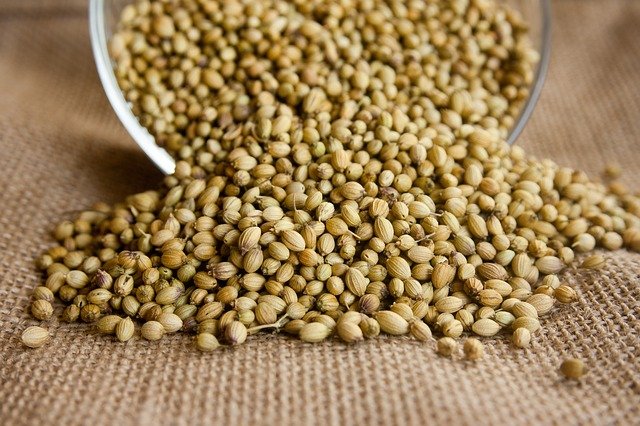
Once cilantro flowers it will then produce coriander seeds. These can then be used whole or ground up and used as a spice. Additionally, you might collect the seed to plant new cilantro for the following season. Here’s how:
- Wait for the cilantro flower head to finish flowering. It will develop seeds and start to dry. When the seed head turns mainly brown all over, cut off the seed head at the stem.
- Seed heads can then be placed headfirst into a paper bag.
- Hang the bag, so the seed heads are upside down, in a warm dry area until the stems completely dry out. This can take around 2 weeks.
- During the drying process, many of the seeds will naturally fall off the stems and be collected in the bag. The remaining seed can be shaken from the stem into the paper bag and finally rubbed off from the stem using your fingers.
- Collect the seeds from the paper bag and place them in airtight containers away from direct sunlight. Coriander seed can last at least 12 months if stored correctly.
Cilantro Pests and Diseases
The biggest problem with growing cilantro is the plant’s sensitivity to heat, which causes it to bolt to flower and then seed. But here are a few pests and diseases to also keep an eye on.
Bacterial Leaf Spot – this looks like yellowish to dark brown spots on the cilantro leaves. Control by removing affected leaves, minimize watering overhead, and practice 3-year crop rotation to help eliminate soil contamination. Ensure plants have adequate airflow.
Fusarium Wilt – this fungal infection causes the plant to wilt, collapse, and die. Seed can be diseased so minimize exposure by purchasing disease-free seed. Practice crop rotation and start with healthy soil before sowing or planting the cilantro.
Powdery Mildew – if the cilantro plant develops a white coating on the leaves the likely cause is powdery mildew. This fungal disease is not usually fatal to the plant but it will affect growth and the flavor.
For a natural fungicide spray, this diy milk spray is easy to make at home as well as being safe to use on the plant and for the environment.
Leafhoppers – these insects suck the juices from stems and leaves. Control leafhoppers by spraying them off the plants with water. Alternatively, use horticultural neem oil.
Aphids – these small fluffy-looking insects suck the sap from the stems and leaves. An effective treatment is hosing them off with the garden hose or using insecticidal soap.
Conclusion
Growing cilantro is a flavorful and aromatic addition to the herb garden. By succession planting new seeds regularly during the growing season, you can be harvesting cilantro for many months. And nothing beats the satisfaction of picking your own cilantro from the garden whenever you need it. So why not try growing cilantro in your garden?
Recommended Products
- Soil, Light and Water Gauge
- Organic Herb Fertilizer
- Seed Raising Potting Mix
- Organic Potting Mix
- Seed Starter Peat Pots
- Water Spray Bottle – for gently watering seeds.
- Food Dehydrator
- Horticultural Neem Oil
Further reading:
- How To Grow Mint: Complete Guide To Growing Mint At Home
- 7 Tips To Successfully Grow Basil At Home
- How To Grow Ginger: Guide To Growing Ginger At Home
- Drought Hardy Herbs To Plant At Home
- How to Grow Lemongrass: Planting and Growing Guide
- How to Grow Chives in Your Herb Garden
- Dying Chives? 6 Common Causes with Solutions
- Growing African Blue Basil: Plant Profile and Propagating
- What’s Eating My Mint? (Holes in Mint Leaves)
